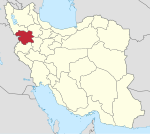Vey Nesar
Persian: وينسار | |
|---|---|
Village | |
| Coordinates: 35°01′37″N 48°04′49″E / 35.02694°N 48.08028°E[1] | |
| Country | Iran |
| Province | Kurdistan |
| County | Qorveh |
| District | Chaharduli |
| Rural District | Chaharduli-ye Sharqi |
| Population (2016)[2] | |
| • Total | 2,350 |
| Time zone | UTC+3:30 (IRST) |
Vey Nesar (Persian: وينسار)[a] is a village in, and the capital of, Chaharduli-ye Sharqi Rural District of Chaharduli District, Qorveh County, Kurdistan province, Iran.[4]
Demographics
[edit]Language
[edit]Linguistic composition of the village:[5]
Population
[edit]At the time of the 2006 National Census, the village's population was 2,249 in 547 households.[6] The following census in 2011 counted 2,362 people in 632 households.[7] The 2016 census measured the population of the village as 2,350 people in 683 households. It was the most populous village in its rural district.[2]
See also
[edit]Notes
[edit]References
[edit]- ^ OpenStreetMap contributors (18 August 2023). "Vey Nesar, Qorveh County" (Map). OpenStreetMap (in Persian). Retrieved 18 August 2023.
- ^ a b "Census of the Islamic Republic of Iran, 1395 (2016)". AMAR (in Persian). The Statistical Center of Iran. p. 12. Archived from the original (Excel) on 8 May 2022. Retrieved 19 December 2022.
- ^ Vey Nesar can be found at GEOnet Names Server, at this link, by opening the Advanced Search box, entering "-3088340" in the "Unique Feature Id" form, and clicking on "Search Database".
- ^ Mousavi, Mirhossein (18 May 1366). "Creation and formation of 11 rural districts including villages, farms and places in Qorveh County under Kurdistan province". Islamic Parliament Research Center (in Persian). Ministry of Interior, Council of Ministers. Archived from the original on 18 July 2014. Retrieved 23 January 2024.
- ^ Mohammadirad, Masoud; Anonby, Erik; et al. "Language distribution in Kordestan Province, Iran". Atlas of the languages of Iran (ALI). Geomatics and Cartographic Research Centre, Carleton University. Archived from the original on 28 May 2023.
- ^ "Census of the Islamic Republic of Iran, 1385 (2006)". AMAR (in Persian). The Statistical Center of Iran. p. 12. Archived from the original (Excel) on 20 September 2011. Retrieved 25 September 2022.
- ^ "Census of the Islamic Republic of Iran, 1390 (2011)". Syracuse University (in Persian). The Statistical Center of Iran. p. 12. Archived from the original (Excel) on 19 January 2023. Retrieved 19 December 2022.



Well, that’s interesting to know that Psilotum nudum are known as whisk ferns. Psilotum nudum is the commoner species of the two. While the P. flaccidum is a rare species and is found in the tropical islands. Both the species are usually epiphytic in habit and grow upon tree ferns. These species may also be terrestrial and grow in humus or in the crevices of the rocks.
View the detailed Guide of Psilotum nudum: Detailed Study Of Psilotum Nudum (Whisk Fern), Classification, Anatomy, Reproduction